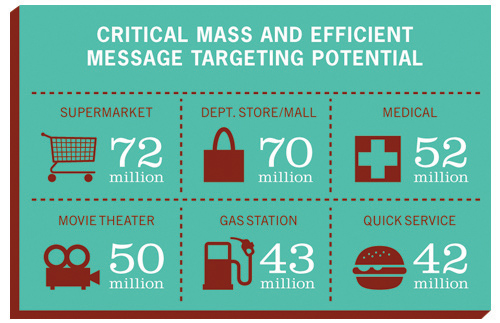Digital place-based media and maximizing return on ad spending.
Running a TV ad in the supermarket aisle when the customer is finalizing their brand selection is a no brainer. Digital place based media, or in-store digital, was originally designed to be one further push for the consumer at the point of purchase. It made perfect sense; consumers often enter a store without a firm brand selection in mind. Once in the store, the plethora of conflicting packaging and messages can be overwhelming.
Knock, knock. Who’s there? Place-based digital media.
In a store with a million brand choices, digital media is just the ticket to make a particular brand stand out in all the clutter – inspiring consumers to make that one right choice.
Knock, knock. Who else is there? Results.
According to a recent AdAge article, “Over the past decade, the store has become the single leading driver of awareness of new package-goods products, significantly passing TV.” A digital in-store message offers the best of both worlds – a timely message in a TV spot format that cuts through much of the overwhelming mish-mash of in-store promotion.
 The supermarket is a unique purchasing destination. Many of the products are commodity items that don’t enjoy unshakable brand loyalty. The products advertised are in a high volume retail environment and are the ones currently at the customer’s fingertips. This makes for the highest possible contextual combination, basically resulting in message targeting on steroids.
The supermarket is a unique purchasing destination. Many of the products are commodity items that don’t enjoy unshakable brand loyalty. The products advertised are in a high volume retail environment and are the ones currently at the customer’s fingertips. This makes for the highest possible contextual combination, basically resulting in message targeting on steroids.
Digital place-based media in supermarkets follows the golden rule of critical mass and efficient message targeting. A recent Arbitron study confirms that this strategy has successfully garnered high levels of unique visitors over a month for grocery stores (72 million). According to the study, 19 percent of those who saw an ad made an unplanned purchase.
 In addition to supermarkets, there are other types of retail that could take advantage of the “critical mass and efficient message targeting” rule, such as large department stores and malls. Study results show in high numbers of redirected, reinforced and even unplanned purchases among monthly unique visitors at large department stores and malls – 69 million and 70 million, respectively.
In addition to supermarkets, there are other types of retail that could take advantage of the “critical mass and efficient message targeting” rule, such as large department stores and malls. Study results show in high numbers of redirected, reinforced and even unplanned purchases among monthly unique visitors at large department stores and malls – 69 million and 70 million, respectively.
 The numbers are particularly impressive considering that visitors to these particular locations tend to move with purpose as opposed to other venues where there are captive audiences for extended periods of time, such as doctors’ offices. By the nature of these high traffic and high clutter venues, visitors are typically bombarded by a multitude of demands on their time and attention. A TV spot with eye-catching and compelling creative is proving to be a substantial means of garnering the consumer’s attention.
The numbers are particularly impressive considering that visitors to these particular locations tend to move with purpose as opposed to other venues where there are captive audiences for extended periods of time, such as doctors’ offices. By the nature of these high traffic and high clutter venues, visitors are typically bombarded by a multitude of demands on their time and attention. A TV spot with eye-catching and compelling creative is proving to be a substantial means of garnering the consumer’s attention.
 But not everyone looks to reach the audience that frequents supermarkets and malls. Venues that also enjoy a high volume of unique visitors are medical offices at 52 million unique visitors monthly, movie theaters at 50 million, gas stations at 43 million and Quick Service Restaurants at 42 million. In these venues, the messages vary from extremely targeted (such as selling diapers in an obstetrician’s office) to selling a mixed bag of loosely related products and services (such as advertising soft drinks at a gas station). In many cases, these products or services are not sold at the same place the video is viewed, thus removing the “path to purchase” from the actual purchase event and eliminating the impulse buy.
But not everyone looks to reach the audience that frequents supermarkets and malls. Venues that also enjoy a high volume of unique visitors are medical offices at 52 million unique visitors monthly, movie theaters at 50 million, gas stations at 43 million and Quick Service Restaurants at 42 million. In these venues, the messages vary from extremely targeted (such as selling diapers in an obstetrician’s office) to selling a mixed bag of loosely related products and services (such as advertising soft drinks at a gas station). In many cases, these products or services are not sold at the same place the video is viewed, thus removing the “path to purchase” from the actual purchase event and eliminating the impulse buy.

Where food store chains have stuck to a firm point-of-sale promotion to educate customers and introduce new products, they have enjoyed as much as a 46 percent increase in sales. Other marketers believe in more of a “Life Pattern Marketing”TM (SeeSaw Network) experience where the consumer can see the TV spot at home in the morning, again at the gas station, once more at their local gym and then finally at the point-of-purchase in the supermarket. They believe that the “psychological impact on a consumer getting the brand message in many contexts permeates the ‘noise’ and builds awareness and retention.” Brand ubiquity is a worthy but expensive goal. A far more challenging and rewarding goal is to create the perception of brand ubiquity – and that’s where true targeting replaces mass coverage.
If your product lends itself to a point-of-purchase digital experience and you create an engaging consumer message, an in-store program should yield a desirable return on your investment. If your experience is contextual but removed from point-of-sale, you stand to lose some momentum unless you’ve managed to create brand ubiquity and have your consumer locked and loaded.



